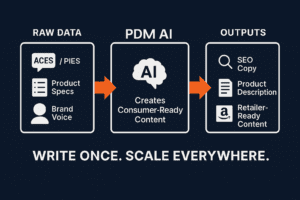Source: 2025 Toyota Tacoma Trail Hunter
OEMs like Toyota, Ford, Jeep, and General Motors have a successful history of partnering with aftermarket brands to produce high-performance models from the factory.
The reason is simple: people want to customize their vehicles. Manufacturers realized that factory vehicles with top aftermarket equipment and a warranty boost revenue and build brand loyalty. Aftermarket brands benefit from selling at scale, while buyers get high-performance vehicles.
Aftermarket specials are a true win/win in the automotive industry.
Wide range of benefits to OEMs
Source: Hot Rob Henry’s, El Dorado Hills, CA, 1955
OEMs (Original Equipment Manufacturers) have recognized strategic and financial benefits in engaging with the aftermarket industry since the 1950s.
Long-term revenue opportunities
Consumers spend on upgrades and enhancements long after purchasing, creating continuous revenue.
Market expansion
Engaging with the aftermarket allows OEMs to reach niches like car enthusiasts and professional racers.
Brand differentiation
Offering aftermarket parts or collaborations differentiates brands in a competitive market.
Customer retention
Official aftermarket support helps retain customers within the brand ecosystem.
Innovation and feedback loop
Aftermarket engagement encourages innovation and provides valuable user feedback for future models.
Huge benefits to aftermarket brands
When aftermarket brands form associations with established OEMs, they increase their credibility and visibility within the industry.
These partnerships often act as endorsements from well-respected OEMs, suggesting a level of quality that can help build customer confidence. By aligning themselves with manufacturers, aftermarket brands can leverage the OEMs’ established reputations and extensive marketing and distribution networks. This exposure is invaluable for brands looking to expand beyond their traditional customer bases.
Specialized models with aftermarket parts
When it comes to aftermarket specials, there are generally two unique sectors of high-performance vehicles featuring aftermarket parts that are available from the factory: performance street vehicles and capable off-road machines.
High-performance street machines
Source: Source: 1965 Shelby Mustang GT350s
The tradition of modifying street cars dates back to the 1930s. By the muscle car era of the late 1950s and 1960s, manufacturers like Ford produced specialized models, such as the Shelby GT350, in collaboration with aftermarket brands.
Source: 2024 Saleen 302 White Label
Off-road Capability
Source: 1971 Bill Stroppe Baja Bronco
As much as people love to modify their street machines, the off-road sector may just have the upper hand when it comes to partnerships with aftermarket brands. One of the earliest examples is the partnership between off-road racer Bill Stroppe, famous for winning the Baja 500, and Ford’s Bronco team.
Ford handled the initial build and then shipped specially prepped Broncos to Stroppe’s shop in Long Beach, California, for final conversion. Stroppe added rear fender flares and trimmed the front fenders to accommodate the Gates Commando XT tires, which were mounted on either painted steel wheels or 8.5×15-inch slot mags. The Baja Bronco conversion also featured dual shocks at each wheel, a padded rollbar, a rubberized steering wheel, front bumper braces, a trailer hitch, and Baja Bronco-branded tire covers and fender decals.
Stroppe’s catalog of off-road parts and accessories presented a broad array of choices, ranging from racing seats, harnesses, and auxiliary lighting to Phase 1 and Phase 2 performance enhancements. Phase 1 upgrades typically involved modifications for the standard 302 engine, including headers, dual exhaust systems, and a Holley four-barrel carburetor. This level of customization is incredible, considering it was 50+ years ago.
Source: 2024 Jeep Wrangler Rubicon with factory aftermarket upgrades
Today, the off-road industry is a huge sector in the automotive industry. Models like the Jeep Wrangler offer aftermarket components from brands like Warn, Dana, Rancho, Black Rhino, and many more from the factory. Customers can roll performance parts into their payment and receive support at the dealer if any issues arise.
For 2025, Toyota is rolling out their aftermarket focused Trail Hunter line, a factory model designed with overlanding in mind.
The Trailhunter is equipped to handle any adventure with features like a high-clearance front bumper, ARB® steel rear bumper, frame-mounted rock rails, and steel underbody protection. It rides on 33-inch Goodyear® Territory® R/T tires and 18-inch bronze-finished wheels, enhancing both its off-road capability and ground clearance. The standard Old Man Emu® suspension with 2.5-inch forged monotube shocks ensures stability and durability off the grid.
Future trends in aftermarket collaboration
The relationship between OEMs and aftermarket brands is poised to evolve in ways that reflect industry trends, such as increased customization and integration of technology.
As consumers continue to demand vehicles that are not only more personalized but also equipped with the latest technology, OEMs and aftermarket brands will collaborate more closely. This partnership will focus on developing specialized models that incorporate advanced aftermarket enhancements right from the factory floor. This trend could lead to OEMs routinely offering upgrade packages that include aftermarket components as part of the new vehicle purchase process.
As electric vehicles (EVs) and autonomous driving technologies gain market share, there will be new opportunities for aftermarket enhancements tailored to these technologies. This could include advanced battery systems, enhanced sensory equipment, or customized software apps. The shift towards more connected and autonomous vehicles will also drive demand for aftermarket products that can retrofit older models with new technology.
Push your aftermarket business to new levels
Our advanced PIM solutions streamline product data management, ensuring accuracy, consistency, and efficiency across your distribution channels. Connect with us today to see how our tailored PIM strategies can enhance your business operations and drive your market success.

More Resources
2024 laws and regulation changes that may affect the automotive aftermarket
What is a PIM and and why it is important for aftermarket brands
Understanding the role of certifications and standards in aftermarket parts quality



